Papers by Michele D'Amato
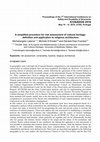
Nowadays comprehensive management plans are needed for conserving and protecting in high natural ... more Nowadays comprehensive management plans are needed for conserving and protecting in high natural risks-prone areas the immovable cultural heritage.
In a previous work a seismic risk assessment procedure was proposed, established by applying two different designing tools addressed to define: seismic vulnerability assessment (Designing Tool 1) and hazard characterization and mapping (Designing Tool 2).
The seismic vulnerability has been evaluated taken into account some structural indicators such as: the building position and the characteristics of its foundations; geometry in plan and in elevation; distance between walls; the type and quality of the resistant system; horizontal and covering structures; the conservation status; alternation in the construction system and in the environment; vulnerability to fire and the presence of secondary elements that could fall after a quake.
On the other hand, the seismic hazard is evaluated also including other threats such as: landslides, erosion, physical stress, volcanic, urban fire, air pollution, hydro meteorological threat and scarce maintenance, making a hierarchy according to the severity of potential damage on the Cultural Property that can increase seismic risk. In this paper some applications to case studies of the proposed procedure are shown. In particular, are performed the seismic risk evaluations of a Chilean and an Italian old masonry churches, both built under the Hispanic Monarchy in both countries between the XVII and XVIII centuries.
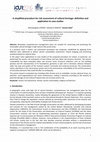
Nowadays comprehensive management plans are needed for conserving and protecting the immovable cu... more Nowadays comprehensive management plans are needed for conserving and protecting the immovable cultural heritage in high natural risks-prone areas. In a previous work a seismic risk assessment procedure was proposed, established by applying three different tools addressed to define: seismic vulnerability assessment, hazard mapping and prioritizing assistance based on cultural value. In this paper some applications to case studies of the proposed procedure are shown. In particular, are performed the seismic risk evaluations of two Chilean and two Italian old masonry churches. The seismic vulnerability has been evaluated taken into account some structural indicators such as: the building position and the characteristics of its foundations; geometry in plan and in elevation; distance between walls; the type and quality of the resistant system; horizontal and covering structures; the conservation status; alterations in the construction system and in the environment; vulnerability to fire and the presence of secondary elements that could fall after an earthquake. The seismic hazard is evaluated also including other threats such as: landslides, erosion, physical stress, air pollution, socio-organizational and scarce maintenance, making a hierarchy according to the severity of potential damage on the Cultural Property that can increase seismic risk.
The conservation of historic buildings cannot be independent of the knowledge of its constitutive... more The conservation of historic buildings cannot be independent of the knowledge of its constitutive features such as: materials, constructive techniques, structural characteristics and building evolution, representing a crucial point for the assessment of seismic risk. In this paper, a procedure for the typological characterization and two simplified procedures for seismic risk assessment are described and critically applied to case studies of churches belonging to the "Sassi of Matera", the historic center of Matera town protected by UNESCO. This methodology is intended to be used at a territorial scale for the planning of preventive conservation of cultural heritage and seismic risk mitigation projects. The obtained results are shown and compared among them, highlighting the aspects that characterize their seismic vulnerability.
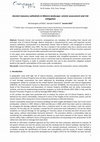
Dramatic human and economic consequences are nowadays still resulting from natural and anthropic ... more Dramatic human and economic consequences are nowadays still resulting from natural and anthropic risks of Cultural Heritage. Matera landscape is characterized by many and important ancient masonry cathedrals, concentrated in its downtown named " Sassi of Matera " , and recognized as Cultural World Heritage by UNESCO since 1993. The city is located in the southern Italy into a seismic-prone area with moderate seismicity. The structural typology and materials identification of these churches represent a crucial point for their structural safety assessment and risks mitigation. In this paper some representative examples are illustrated by remarking the main peculiarities of such structures. Then, some chosen study cases are evaluated with simplified procedures for seismic risk assessment. This approach may be also used in a territorial scale for planning the preventive conservation of the Cultural Property, in order to establish priorities lists and to plan preventive mitigation projects based on the specific vulnerabilities of the cases under consideration.
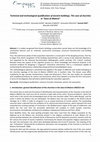
It is widely recognized that historic buildings conservation cannot leave out the knowledge of it... more It is widely recognized that historic buildings conservation cannot leave out the knowledge of its constitutive features such as: materials, constructive techniques, structural characteristics and building evolution.
Thus, the preliminary phase of data acquisition represents a crucial point of the designing process, that has to begin from direct recognition of the building characteristics with a survey of the observed alterations, and supported by the historical documentation (bibliographic and/or archival). The "critical" synthesis between these two aspects of the cognitive process (i.e. direct knowledge and historical analysis) is the essential condition for designing a "congruent" restoration intervention, that is, a restoration capable of synthesizing the dichotomous relationship among technical and philological issues.
This methodological approach is presented and applied in this paper to different case studies belonging to the churches typology of the Sassi di Matera UNESCO site in Southern Italy. The chosen cases differ completely for age, peculiar characteristics, shape and dimensions. Then, the case studies are evaluated with simplified procedures for seismic risk assessment, which have allowed us to draw the first conclusions in terms of the diagnosis that will lead to determining the restoration approach.

Journal of Structural Engineering, 2012
ABSTRACT This paper presents a simplified model for describing the response of a longitudinal bar... more ABSTRACT This paper presents a simplified model for describing the response of a longitudinal bar embedded in concrete, taking into account the bond-slip phenomenon. The model is developed by assuming a linear bond-slip field along the bar anchorage length and provides a simplified stress-strain relationship to assign to the longitudinal reinforcement. The analytical approach adopted makes the proposed model very convenient from a computational standpoint because, unlike many other refined models, it does not require a multilevel iterative process. Moreover, the assumptions made are particularly appropriate for modeling bond-slip of smooth bars generally used in older reinforced concrete buildings. The implementation strategy of the proposed bond-slip model in general-purpose nonlinear structural analysis software and comparisons with experimental results are discussed in a companion paper.
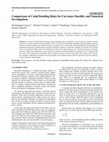
The Open Construction and Building Technology Journal, 2014
In moment resisting frame structures special detailing rules are applied to critical regions of p... more In moment resisting frame structures special detailing rules are applied to critical regions of primary columns and beams to ensure adequate curvature ductility. This is necessary for dissipating earthquake energy through hysteretical behavior of critical regions where inelastic flexural excursions occur. In this paper codal detailing rules for designing longitudinal and transverse reinforcement of primary elements as function of curvature ductility are assessed. Four seismic codes are considered: Italian code, New Zealand code, Eurocode 8 and American code. Non-linear monotonic momentcurvature analyses are performed on some sections of columns and beams detailed in according to the considered codal provisions. In the analyses the confinement effects within the concrete core have been taken into account as well. The paper concludes comparing the measured curvature ductility of the studied sections with the expected one by the codal provisions within the critical regions.
A new uniaxial confined concrete material has been added in OpenSees. The material allows of perf... more A new uniaxial confined concrete material has been added in OpenSees. The material allows of performing non-linear analyses by using the confined concrete model proposed by Braga, Gigliotti and Laterza (named BGL model). The model takes into account different confining arrangements of transverse reinforcements and/or external strengthenings, such as FRP wraps or steel jackets. The BGL model has no tensile strength and degraded unloading/reloading stiffness in accordance to the work of Karsan and Jirsa. The paper shows some applications of the BGL model in OpenSees for simulating the nonlinear response of confined concrete elements.
WIT Transactions on the Built Environment
The paper shows results of two non-linear cyclic analyses performed with OpenSees where slippage ... more The paper shows results of two non-linear cyclic analyses performed with OpenSees where slippage phenomenon of longitudinal bars is pronounced. Bond-slips have modeled by using the simplified model proposed by Braga et al. which assigns an equivalent stress-strain relationship to longitudinal steel accounting for both material elongation and relative slip. The model is also capable to take into account anchorages at bars ends (such as bends or hooks) and has been developed mainly for assessing older existing buildings where, because of the presence of reinforcing plain bars, bond-slips are particularly pronounced. Unlike many other refined models published in literature, the analytical formulation of the proposed model requires a minimum computational effort avoiding any nested iterations loop in the context of fiber model discretization of a section.
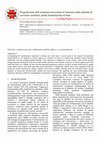
In designing RC membratures subjected to flexure and axial load a crucial point is the amount of ... more In designing RC membratures subjected to flexure and axial load a crucial point is the amount of transverse reinforcement to be applied to critical regions of columns. It allows to achieve the required section ductility coherently with the assumed global ductility. This approach is adopted by recent seismic codes which provide design equations linking the transverse reinforcement amount to the ductility curvature of critical regions and to the axial load ratio of a column. In line with this approach parametric analyses on fiber sections reinforced by simple hoops under flexure and axial load have been performed. Confinement effects have been computed with the analytical model proposed by Braga, . Starting from the obtained results design equation of transverse reinforcement amount has been proposed. By applying the used methodology design equations referring to different arrangements of transverse reinforcement may be proposed in future works.
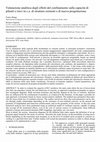
Per la valutazione della capacità delle membrature in cemento armato, le principali normative con... more Per la valutazione della capacità delle membrature in cemento armato, le principali normative consentono l'uso di legami costituivi per il calcestruzzo ritenuti maggiormente rappresentativi del reale comportamento rispetto ai diagrammi tensione-deformazione del tipo parabola-rettangolo o rettangolare equivalente. Sia la resistenza sia la duttilità della sezione sono influenzate dal legame σ−ε del calcestruzzo e pertanto, come è noto, dal livello di confinamento. Nell'articolo si descrive un possibile approccio progettuale, basato sui metodi classici di analisi della sezione, che prevede l'uso del diagramma rettangolare equivalente per il calcestruzzo confinato. Gli studi effettuati mostrano che è possibile descrivere i parametri dello stress-block attraverso semplici relazioni, che dipendono dalla resistenza del calcestruzzo non confinato, dal quantitativo e disposizione dell'armatura trasversale e longitudinale e dalla geometria della sezione. A tale scopo, nelle analisi numeriche è stato adottato un modello analitico per il calcestruzzo confinato capace di portare in conto tutti i fattori elencati, anche nel caso di confinamento misto costituito da armature trasversali in varie configurazioni e rinforzi esterni (in acciaio, FRP, ecc.). In particolare, i domini di interazione per i diversi stati limite richiedono la definizione dei limiti appropriati per la deformazione massima del calcestruzzo. Pertanto, si indica la possibilità di definire gli stress-block in funzione della deformazione massima assunta o del livello di tensione residua del calcestruzzo ritenuto accettabile in funzione dello stato limite considerato. Occorrerà ovviamente ampliare l'analisi parametrica, allo scopo di ricavare equazioni di progetto proponibili in ambito normativo.
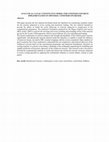
This paper presents the new material developed inside the OpenSees by considering constitute mode... more This paper presents the new material developed inside the OpenSees by considering constitute model for the concrete subjected to revere cycling and monotonic loading. The new material intended to provide the ability of model the cyclic behaviour of concrete subjected to compression in the computational programme. The analytical formulation proposed by the Braga, Gigliotti and Laterza (BGL model, 2006) is used for the envelope and reverse (loading and reloading) action of the material govern by the Yassin (1994) approach, which is given bilinear curve for unloading and loading. The lateral confinement of concrete enhances the strength and durability of the reinforcement concrete significantly. Introducing this uniaxial material inside the OpenSees is capable to model the influence of transverse hoops, ties and/or FRP, external wrapping with the section considered. Many numbers of great researches have been conducted to understand the real compressive and tension behaviour of the reinforced concrete based on the experimental programme and analytical formulations. Research on cycling response of concrete is becoming a challenge of the earthquake engineering for modelling and capable prediction of hysteretic characters of the reinforced concrete. This research work is devoted to develop the computational methods to model and analyse the reinforced concrete structures subjected to revere cycling specially by applying the confinement influence to section (Beam, column or joint panel).
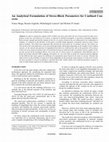
The Open Construction and Building Technology Journal, 2008
In order to evaluate the capacity of RC members, the main codes allow the use of stress-strain la... more In order to evaluate the capacity of RC members, the main codes allow the use of stress-strain laws that can reproduce closely the real behaviour of concrete, as opposed to parabola-rectangular or equivalent rectangular diagrams. Both sectional strength and ductility depend on the law of concrete, therefore they are influenced by the confinement of members, as evidenced in the literature. In this paper a possible design approach is presented, based on classic section analysis methods. The method uses parameters that represent the stress-strain law of confined concrete. The studies carried out show that such parameters can be chosen through simple relationships depending on the strength of non-confined concrete, on the amount and geometry of longitudinal and transverse reinforcement, and on the geometry of the section. At this aim some numerical analyses have been performed using an analytical model of confined concrete, capable of taking into account all the mentioned effects, even in the case of various sources of confinement, when different types of hoops and external elements (FRP wrappings, steel plates, etc.) are used. More in detail, the section interaction diagrams for the different limit states requires the definition of an appropriate upper bound for the strain of concrete. Therefore the study focuses on the possibility of using stress-blocks depending on the maximum stain assumed, or on the level of residual stress accepted in concrete according to a specified limit state. Further studies will extend the parametric analysis in order to obtain design equations to be implemented in codes.
The paper discusses the main aspects related to nonlinear behavior of RC existing buildings. Firs... more The paper discusses the main aspects related to nonlinear behavior of RC existing buildings. Firstly, modeling criteria proposed in previous works are discussed starting from experimental tests performed on RC beam-tocolumn joints. Specimens were designed only for vertical loads with smooth bars and are representative of existing buildings constructed in Italy between 1950s and 1970s. Afterwards, the proposed analytical models are applied for evaluating the nonlinear response of a typical RC existing structure. Comparisons among different modeling criteria by applying capacity models indicated in the Italian seismic code (D.M. 14/01/2008) are shown, as well.











Uploads
Papers by Michele D'Amato
In a previous work a seismic risk assessment procedure was proposed, established by applying two different designing tools addressed to define: seismic vulnerability assessment (Designing Tool 1) and hazard characterization and mapping (Designing Tool 2).
The seismic vulnerability has been evaluated taken into account some structural indicators such as: the building position and the characteristics of its foundations; geometry in plan and in elevation; distance between walls; the type and quality of the resistant system; horizontal and covering structures; the conservation status; alternation in the construction system and in the environment; vulnerability to fire and the presence of secondary elements that could fall after a quake.
On the other hand, the seismic hazard is evaluated also including other threats such as: landslides, erosion, physical stress, volcanic, urban fire, air pollution, hydro meteorological threat and scarce maintenance, making a hierarchy according to the severity of potential damage on the Cultural Property that can increase seismic risk. In this paper some applications to case studies of the proposed procedure are shown. In particular, are performed the seismic risk evaluations of a Chilean and an Italian old masonry churches, both built under the Hispanic Monarchy in both countries between the XVII and XVIII centuries.
Thus, the preliminary phase of data acquisition represents a crucial point of the designing process, that has to begin from direct recognition of the building characteristics with a survey of the observed alterations, and supported by the historical documentation (bibliographic and/or archival). The "critical" synthesis between these two aspects of the cognitive process (i.e. direct knowledge and historical analysis) is the essential condition for designing a "congruent" restoration intervention, that is, a restoration capable of synthesizing the dichotomous relationship among technical and philological issues.
This methodological approach is presented and applied in this paper to different case studies belonging to the churches typology of the Sassi di Matera UNESCO site in Southern Italy. The chosen cases differ completely for age, peculiar characteristics, shape and dimensions. Then, the case studies are evaluated with simplified procedures for seismic risk assessment, which have allowed us to draw the first conclusions in terms of the diagnosis that will lead to determining the restoration approach.
In a previous work a seismic risk assessment procedure was proposed, established by applying two different designing tools addressed to define: seismic vulnerability assessment (Designing Tool 1) and hazard characterization and mapping (Designing Tool 2).
The seismic vulnerability has been evaluated taken into account some structural indicators such as: the building position and the characteristics of its foundations; geometry in plan and in elevation; distance between walls; the type and quality of the resistant system; horizontal and covering structures; the conservation status; alternation in the construction system and in the environment; vulnerability to fire and the presence of secondary elements that could fall after a quake.
On the other hand, the seismic hazard is evaluated also including other threats such as: landslides, erosion, physical stress, volcanic, urban fire, air pollution, hydro meteorological threat and scarce maintenance, making a hierarchy according to the severity of potential damage on the Cultural Property that can increase seismic risk. In this paper some applications to case studies of the proposed procedure are shown. In particular, are performed the seismic risk evaluations of a Chilean and an Italian old masonry churches, both built under the Hispanic Monarchy in both countries between the XVII and XVIII centuries.
Thus, the preliminary phase of data acquisition represents a crucial point of the designing process, that has to begin from direct recognition of the building characteristics with a survey of the observed alterations, and supported by the historical documentation (bibliographic and/or archival). The "critical" synthesis between these two aspects of the cognitive process (i.e. direct knowledge and historical analysis) is the essential condition for designing a "congruent" restoration intervention, that is, a restoration capable of synthesizing the dichotomous relationship among technical and philological issues.
This methodological approach is presented and applied in this paper to different case studies belonging to the churches typology of the Sassi di Matera UNESCO site in Southern Italy. The chosen cases differ completely for age, peculiar characteristics, shape and dimensions. Then, the case studies are evaluated with simplified procedures for seismic risk assessment, which have allowed us to draw the first conclusions in terms of the diagnosis that will lead to determining the restoration approach.